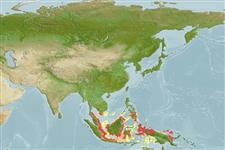>
Carangaria/misc (Various families in series Carangaria) >
Polynemidae (Threadfins)
Etymology: Filimanus: Latin, filum = thread + latin, manus = hand (Ref. 45335); heptadactyla: From the Greek hept, meaning seven, and dactyl, finger, in reference to the seven pectoral filaments typically present (Ref. 39607).
More on author: Cuvier.
Environment: milieu / climate zone / depth range / distribution range
Ecologie
marien; brak water demersaal. Tropical; 10°N - 11°S, 99°E - 148°E (Ref. 57343)
Western Pacific: Thailand, Malaysia and Indonesia to Papua New Guinea. All records in Indian Ocean are misidentifications for other species: Filimanus similis, Polydactylus mullani, Polydactylus sextarius (Ref. 57343).
Grootte / Gewicht / Leeftijd
Maturity: Lm ? range ? - ? cm
Max length : 38.0 cm TL mannelijk / geslacht onbekend; (Ref. 57343)
Dorsale stekels (totaal) : 9; Dorsale zachte stralen (totaal) : 12 - 13; Anale stekels: 3; Anale zachte stralen: 11 - 12; Wervels: 24. 7 pectoral filaments, third or fourth filament, from ventralmost, the longest, not reaching midpoint of anal fin (Ref. 9685). Body brown above and golden below; fins yellow with black at least at margins; pectorals often mostly black (Ref. 9685).
Found on open sandflats and muddy substrates (Ref. 57343).
Levenscyclus en paargedrag
Maturiteit | Voortplanting | Paaien | Eieren | Fecunditeit | Larven
Motomura, H., 2004. Threadfins of the world (Family Polynemidae). An annotated and illustrated catalogue of polynemid species known to date. FAO Spec. Cat. Fish. Purp. Rome: FAO. 3:117 p. (Ref. 57343)
Status op de Rode Lijst van het IUCN (Ref. 130435: Version 2024-2)
Gevaar voor de mens
Harmless
Gebruik door de mens
Visserij: van geen belang
Tools
Speciale rapporten
Download XML
Internetbronnen
Estimates based on models
Preferred temperature (Ref.
123201): 28.5 - 29.3, mean 28.9 °C (based on 527 cells).
Fylogenetische diversiteitsindex (Ref.
82804): PD
50 = 0.5156 [Uniqueness, from 0.5 = low to 2.0 = high].
Bayesian length-weight: a=0.00676 (0.00308 - 0.01483), b=3.10 (2.92 - 3.28), in cm total length, based on LWR estimates for this (Sub)family-body shape (Ref.
93245).
Trofisch niveau (Ref.
69278): 4.0 ±0.50 se; based on food items.
Generation time: 1.7 ( na - na) years. Estimated as median ln(3)/K based on 2
growth studies.
Weerstandsvermogen (Ref.
120179): Hoog, minimale populatieverdubbelingstijd minder dan 15 maanden (Preliminary K or Fecundity.).
Fishing Vulnerability (Ref.
59153): Low vulnerability (21 of 100).
